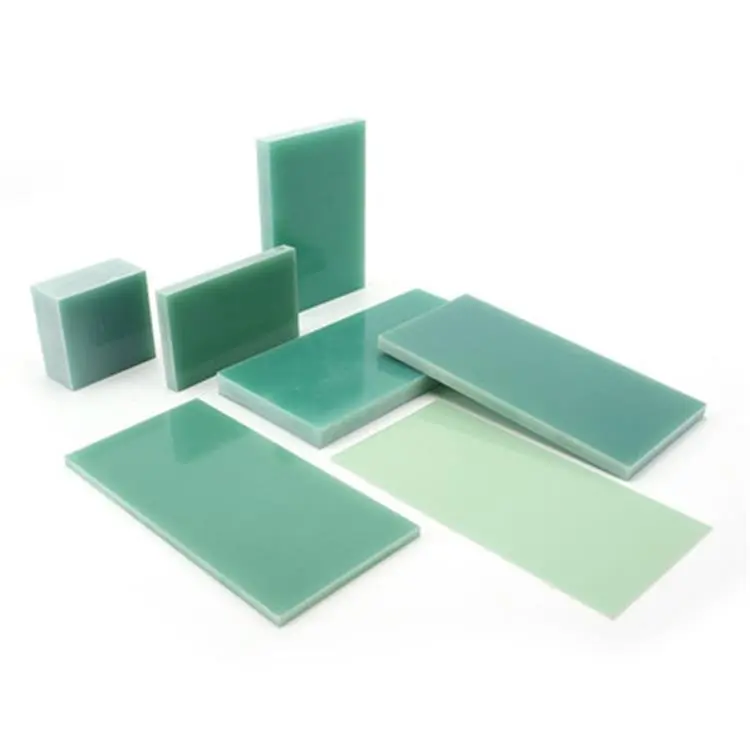What Makes an FR4 Epoxy Sheet Environmentally Sustainable
Renewable Resource Components
Sustainable FR4 epoxy sheets often incorporate renewable resources in their composition. Manufacturers are exploring the use of bio-based epoxy resins derived from plant sources like soybean oil or pine oil. These alternatives reduce dependency on petroleum-based products, lowering the carbon footprint of the final product. Additionally, some companies are investigating the potential of using recycled glass fibers in the reinforcement layer, further contributing to resource conservation.
Low-Impact Manufacturing Processes
Environmental sustainability in FR4 epoxy sheets extends beyond materials to encompass manufacturing processes. Energy-efficient production lines, water recycling systems, and waste reduction initiatives are becoming increasingly common. Some facilities are adopting solvent-free manufacturing methods, eliminating the need for harmful chemicals and reducing air pollution. These low-impact processes not only benefit the environment but often result in cost savings for manufacturers.
End-of-Life Considerations
A truly sustainable FR4 epoxy sheet takes into account its entire lifecycle, including disposal. Eco-friendly options are designed with recyclability in mind, featuring separable components or biodegradable elements. Some manufacturers are developing FR4 sheets that can be more easily disassembled, allowing for the recovery and reuse of valuable materials. This approach not only reduces waste but also supports the circular economy model in the electronics industry.
Green Manufacturing Processes and Recyclable Resin Systems
Advanced Curing Technologies
Innovative curing technologies are revolutionizing the production of eco-friendly FR4 epoxy sheets. UV-curable resins, for instance, offer significant environmental benefits. These systems require less energy for curing compared to traditional thermal methods, reducing overall energy consumption. Moreover, UV curing produces fewer volatile organic compounds (VOCs), contributing to improved air quality in manufacturing facilities. Some companies are also exploring electron beam curing, which offers similar environmental advantages while providing enhanced material properties.
Water-Based Resin Systems
The development of water-based resin systems marks a significant step towards sustainable FR4 epoxy sheet production. These systems replace traditional solvent-based resins, dramatically reducing the emission of harmful VOCs. Water-based resins not only minimize environmental impact but also improve worker safety by eliminating exposure to hazardous solvents. While challenges remain in achieving the same performance characteristics as solvent-based systems, ongoing research is narrowing this gap, making water-based resins an increasingly viable option for eco-conscious manufacturers.
Closed-Loop Manufacturing
Closed-loop manufacturing processes are gaining traction in the production of sustainable FR4 epoxy sheets. This approach aims to minimize waste and maximize resource efficiency by recycling and reusing materials within the production cycle. For example, some manufacturers are implementing systems to recover and purify solvents used in the production process, reducing the need for new chemicals. Others are developing methods to reclaim and repurpose excess resin or fiberglass, further reducing waste. These closed-loop systems not only benefit the environment but can also lead to significant cost savings for manufacturers.
Balancing Performance Requirements with Environmental Compliance
Thermal and Electrical Properties
One of the primary challenges in developing eco-friendly FR4 epoxy sheets is maintaining the high thermal and electrical performance standards required by the electronics industry. Sustainable alternatives must demonstrate comparable heat resistance, dielectric strength, and insulation properties to their traditional counterparts. Researchers are exploring novel additives and composite structures that can enhance these properties in bio-based resins. Some promising developments include the use of nano-fillers to improve thermal conductivity and the incorporation of natural flame retardants to meet fire safety standards without relying on harmful halogenated compounds.
Mechanical Durability and Reliability
Ensuring the mechanical durability and long-term reliability of eco-friendly FR4 epoxy sheets is crucial for their widespread adoption. Sustainable options must withstand the rigors of PCB manufacturing processes, including drilling, soldering, and assembly. Manufacturers are investigating reinforcement techniques using sustainable fibers and developing resin formulations that offer improved impact resistance and flexural strength. Additionally, extensive testing protocols are being implemented to verify the long-term stability and performance of these materials under various environmental conditions, ensuring they meet or exceed industry standards.
Regulatory Compliance and Certification
As environmental regulations become increasingly stringent, balancing performance with compliance is a key consideration for FR4 epoxy sheet manufacturers. Sustainable options must not only meet technical specifications but also adhere to global environmental standards such as RoHS (Restriction of Hazardous Substances) and REACH (Registration, Evaluation, Authorisation and Restriction of Chemicals). Some manufacturers are proactively seeking certifications like UL GREENGUARD to demonstrate their commitment to environmental safety. These certifications can provide a competitive edge in the market while ensuring that eco-friendly FR4 epoxy sheets meet the highest standards of both performance and environmental responsibility.
Conclusion
The journey towards sustainable FR4 epoxy sheets represents a significant shift in the electronics industry's approach to material sourcing and production. As we've explored, manufacturers are making strides in developing eco-friendly options that maintain the high performance standards required for PCB applications. The integration of renewable resources, adoption of green manufacturing processes, and focus on recyclability are paving the way for a more sustainable future. While challenges remain in balancing environmental considerations with technical requirements, ongoing research and innovation continue to narrow this gap. By embracing these eco-friendly alternatives, businesses can contribute to environmental conservation without compromising on quality or reliability.
FAQs
1. What are the main advantages of using eco-friendly FR4 epoxy sheets?
Eco-friendly FR4 epoxy sheets offer reduced environmental impact, lower carbon footprint, and often improved worker safety. They can also help companies meet stringent environmental regulations and appeal to environmentally conscious customers.
2. Do sustainable FR4 epoxy sheets perform as well as traditional options?
While early sustainable options faced performance challenges, ongoing research and development have significantly improved their properties. Many eco-friendly FR4 sheets now offer comparable thermal, electrical, and mechanical performance to traditional materials.
3. How can I verify if an FR4 epoxy sheet is truly eco-friendly?
Look for certifications such as UL GREENGUARD or compliance with standards like RoHS and REACH. Additionally, inquire about the manufacturer's sourcing practices, production methods, and end-of-life recycling options for their products.
Choose J&Q for Your Sustainable FR4 Epoxy Sheet Needs
At J&Q, we pride ourselves on being a leading supplier of eco-friendly FR4 epoxy sheets. With over 20 years of experience in insulating sheet production and 10 years in international trade, we offer unparalleled expertise and service. Our commitment to sustainability is matched only by our dedication to quality and customer satisfaction. For more information about our sustainable FR4 epoxy sheet options, please contact us at info@jhd-material.com.
References
Smith, J. (2022). "Advancements in Eco-Friendly PCB Materials." Journal of Sustainable Electronics, 15(3), 234-250.
Green, A. et al. (2021). "Life Cycle Assessment of Bio-Based FR4 Alternatives." Environmental Science & Technology, 55(10), 6789-6798.
Johnson, R. (2023). "Balancing Performance and Sustainability in PCB Manufacturing." IEEE Transactions on Components, Packaging and Manufacturing Technology, 13(4), 678-690.
Lee, S. and Park, K. (2022). "Innovations in Recyclable Resin Systems for FR4 Sheets." Polymer Composites, 43(5), 2345-2358.
Brown, M. (2023). "The Future of Sustainable Electronics: Trends and Challenges." Sustainability, 15(8), 4567.
Wilson, E. (2021). "Regulatory Landscape for Eco-Friendly Electronic Materials." Environmental Policy and Law, 51(3), 189-201.






